Physical Address
304 North Cardinal St.
Dorchester Center, MA 02124
Atrioventricular (AV) canal defects include a spectrum of lesions in which the common etiology appears to be abnormal development of the endocardial cushions, resulting in a defect in the AV septum and AV valves. This group of lesions forms approximately 3% of all major congenital cardiac defects, and approximately half of the patients have Down syndrome. In children with Down syndrome, AV canal defects are seen in 20% to 25%—a 1000-fold increased risk when compared with the incidence in the general population.
Although AV canal defects constitute a continuum of related anatomic lesions, it is useful to divide them into two main groups —partial and complete AV canal defects—on the basis of the extent of the interventricular communication.
Partial AV canal defects consist of a large ostium primum atrial septal defect (ASD) and a cleft between the left superior and inferior bridging leaflets. In most cases, there is no interventricular communication. However, when the cleft extends to the crest of the interventricular septum, a small shunt can occur at this location between the two ventricles. There are generally two distinct AV valve orifices, corresponding to the mitral and tricuspid valves. Leaflet tissue joins the left superior and inferior leaflets together at the crest of the interventricular septum, eliminating the interventricular communication. In general, partial AV canal defects constitute approximately 5% to 10% of all ASDs.
Complete AV canal defects constitute the other end of the spectrum and are the most common form of AV canal defects. There is generally an ostium primum ASD and a nonrestrictive ventricular septal defect (VSD) in the inlet portion of the interventricular septum. One common AV valve orifice is present, with left and right components. An inlet-septal VSD alone does not fall under the heading of AV canal defects, because the AV septum is intact in these malformations and the AV valves usually form normally. On the other hand, some patients have an inlet-septal VSD and a cleft mitral valve with a restrictive or absent interatrial communication; these should be considered to be in the spectrum of AV canal defects.
In this chapter, we describe the principal anatomic features relevant to the preoperative evaluation and surgical management of defects amenable to a two-ventricle repair, and we briefly discuss the features that may preclude such an approach. Surgical techniques with early and late results are described. Various associated cardiac lesions are discussed, in addition to the management of recurrent mitral regurgitation. We will not discuss the management of AV canal defects associated with heterotaxy syndrome, because the AV canal defect is not the primary pathophysiologic abnormality, and because the anatomy of the AV valve and leaflet configuration are quite different from those of AV canal defects.
The anatomic malformation that is common to all forms of AV canal defects is a deficiency in the AV septum caused by incomplete embryonic development of superior and inferior endocardial cushion tissue. The common AV canal is normally present during the early tubular stage of fetal life and constitutes the sole connection between the primitive common atrium and the primitive common ventricle. After cardiac looping, the valves of the heart develop in the embryo from precursor structures, called endocardial cushions . These endocardial swellings become populated by valve precursor cells formed by a transformation from endothelial to mesenchymal tissue, and they undergo directed growth and remodeling to form the valvular structures and the membranous septa of the mature heart ( Fig. 116-1 ). Abnormal differentiation and remodeling of the cushion mesenchyme into valvuloseptal tissue is thought to be a mechanism for the development of AV canal defects. The resultant anatomic defect involves the abnormal development of AV valves and the persistence of interatrial and interventricular communications.
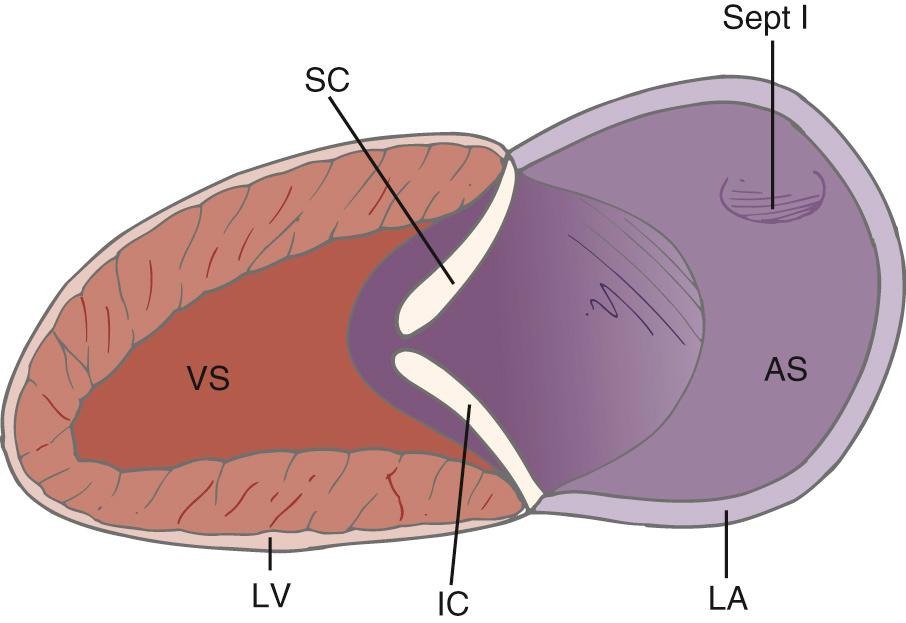
The wide variability in the degree of development of the endocardial cushions explains the variability in size and extent of the septal defects and the degree of involvement of the AV valves. Nevertheless, several anatomic features are shared between all types of AV canal defects. These include the following:
Shortened dimension of the inlet septum-to-ventricular apex, giving the interventricular septum a “scooped-out” appearance. This deficiency in the inlet septum is typically deeper in complete AV canal defects than in partial AV canal defects.
Lengthened dimension of the outlet septum-to-ventricular apex, resulting in a goose-neck appearance and anterior displacement of the left ventricular (LV) outflow tract. Although the LV outflow tract appears narrow, true LV outflow tract obstruction (LVOTO) is rare in the absence of accessory chordal attachments of the AV valve leaflets to the outflow tract. In the normal heart, the inlet-septum-to-ventricular-apex length and the outlet-septum-to-ventricular-apex length are equal.
Absence of the usual wedged position of the aortic valve between the AV valves, caused by maldevelopment of the endocardial cushions. This results in elevation and anterior deviation of the aortic valve.
Decreased contribution of the left lateral leaflet to AV valve circumference. In the normal situation, the posterior mitral leaflet forms two thirds of the mitral valve circumference. In AV canal defects, the left lateral leaflet, which corresponds to the posterior mitral leaflet in the normal heart, forms only a third or less of the circumference of the AV valve.
Inferior displacement of the AV node and coronary sinus. The bundle of His is also displaced inferiorly, coursing at the inferior rim of the scooped-out basal portion of the interventricular septum.
In addition to these fundamental concepts, anatomic features of significance to the surgeon include the following:
Size and extent of the interventricular and interatrial communications
Valve leaflet morphology, including papillary muscle anatomy, valve regurgitation, and presence of chordal attachments to the septum
Relative balance of the common AV valve orifice over the two ventricles
Other major associated cardiac and noncardiac defects
The AV valve in a canal defect has an area of apposition of leaflets that, unlike a normal commissure, is not supported by a papillary muscle. This area of apposition is called a cleft, and it is the apposition of the superior and inferior bridging leaflets. This cleft is not a commissure, as was once thought, for two reasons. First, a commissure is generally supported by chordae on either side of the defect, whereas a cleft is unsupported, with paucity of chordae at the edges. Second, the chordae that arise from the two adjacent leaflets in a commissure usually attach to a single papillary muscle, which promotes coaptation and prevents regurgitation. The chordae that arise from the left superior and inferior leaflets attach to two different papillary muscles; this increases the distracting force during ventricular systole and predisposes to regurgitation through the cleft. The extent of regurgitation is generally mild to moderate, although severe regurgitation can be present.
In 1966, Rastelli and colleagues described a classification of complete AV canal defect based on the extent of bridging of the left superior leaflet (LSL) across the interventricular septum ( Fig. 116-2 ). In complete AV canal defects, the left inferior leaflet (LIL) is not well developed; it is usually short and immobile, with rolled edges. The Rastelli classification does not take into consideration the LIL, which displays greater anatomic variation. No clear morphologic relationship exists between the LSL and the LIL.
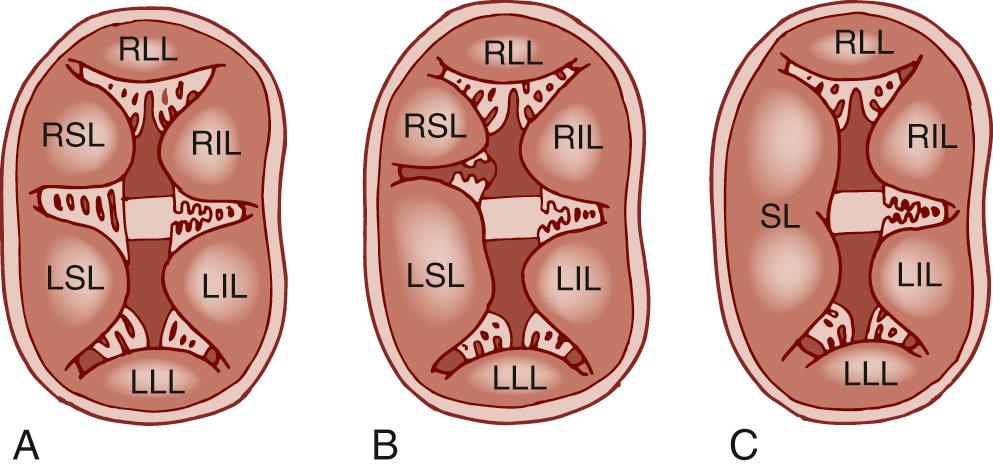
The most common Rastelli type, present in approximately 55% of patients, is the Rastelli A defect. There is no bridging of the LSL; instead, its chordae attach to the crest of the interventricular septum. The superior bridging leaflet can be divided into left and right components over the crest of the interventricular septum. The inferior bridging leaflet is rarely divided and is often attached by short, dense chordae to the crest of the interventricular septum.
In the rare Rastelli B defect, the superior bridging leaflet is often partially divided into right and left components, with associated mild to moderate bridging of the LSL. Its chordae attach either to the right of the crest of the interventricular septum or to a prominent papillary muscle in the right ventricle, depending on the extent of bridging. The moderator band is often short. The Rastelli B subtype is often associated with unbalanced AV canal defect.
In the Rastelli C defect, there is extensive bridging of the LSL. Its chordae are free floating and are not attached to the underlying crest of the interventricular septum but rather to the anterolateral papillary muscle of the right ventricle. The Rastelli C type of complete AV canal defect can be seen in association with other complex heart lesions such as tetralogy of Fallot (TOF), transposition of the great arteries (TGA), and double-outlet right ventricle (DORV).
The development of the Rastelli classification facilitated the widespread application of corrective surgery for this defect. Although it is an oversimplification and represents categorization of a continuum of leaflet abnormalities, it may still have a limited role in the repair of complete AV canal defects using the classic single-patch technique. In that setting, recognition of whether the bridging leaflets are undivided over the crest of the interventricular septum is important because undivided leaflets need to be surgically incised into right and left components to allow placement of a patch to close the interventricular and interatrial communications. Even in those settings, however, the Rastelli classification may have limited applications because neither the extent nor the location of naturally occurring divisions in the bridging leaflets is taken into account. The Rastelli classification is of less importance in the double-patch or modified single-patch techniques that are described later in the chapter.
Lev's description of the location of the conduction tissue was another important contribution in the field, because it facilitated the development of surgical techniques that avoided injury to the His bundle and the AV node. The coronary sinus ostium and the AV node are displaced inferiorly in AV canal defects. The AV node lies at the junction of the interatrial septum and the hinge point of the AV valve. This places the AV node between the coronary sinus ostium and the crest of the interventricular septum, in the so-called nodal triangle, which is not at the tip of Koch's triangle. The nodal triangle is bound by the inferior extent of the right AV valve annulus, the coronary sinus orifice, and the inferior edge of the interatrial septum ( Fig. 116-3 ). The bundle of His then passes superiorly and anteriorly from the AV node to the crest of the interventricular septum, reaching it where the crest is fused posteriorly with the AV valve annulus. The bundle then travels along the crest of the interventricular septum, in an inferior-to-superior direction, giving rise to the left bundle branches. Before reaching the midpoint of the interventricular crest, it becomes the right bundle branch and heads toward the moderator band and the muscle of Lancisi. The superior aspect of the interventricular septum is devoid of conduction fibers. The only exception is that, in patients with complete AV canal defects and heterotaxy syndrome, two AV nodes may be found.
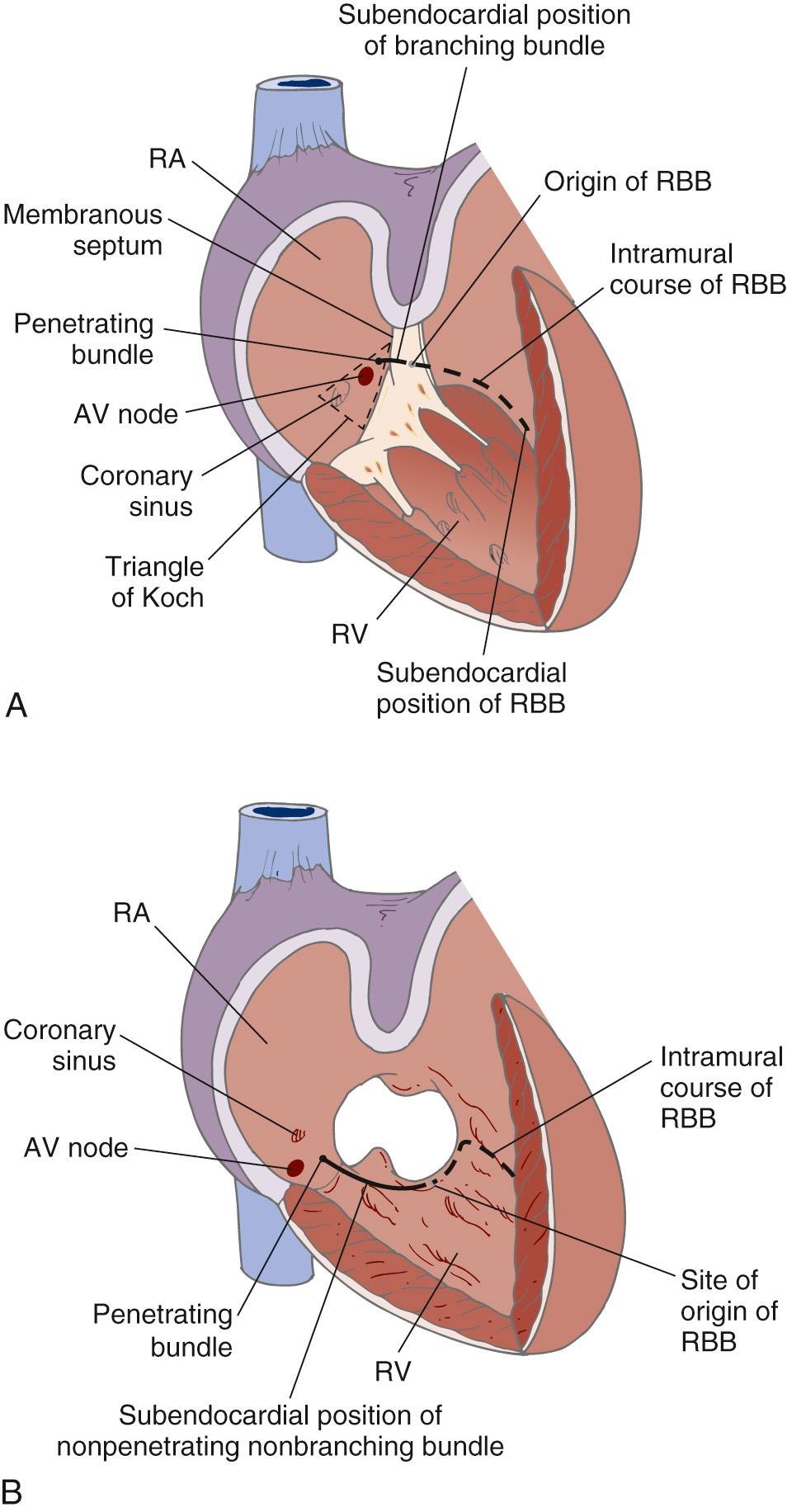
The relationship between the common AV valve and the ventricles varies. If the AV valve is situated primarily over one ventricle, associated hypoplasia of the contralateral ventricle frequently occurs, which in extreme cases precludes a two-ventricle repair. Abnormal papillary muscle development, such as two closely spaced papillary muscles or a single papillary muscle, is seen in right ventricle–dominant forms of complete AV canal defect. In left-dominant forms, often the papillary muscles are closely spaced and fused to the septum, giving the appearance of chordal attachments to the septum. In fact, the papillary attachments to the septum can usually be divided to achieve a two-ventricle repair in many of these patients.
Approximately 50% to 75% of patients with complete AV canal have Down syndrome, whereas Down syndrome is rare in patients with partial AV canal defects, occurring in less than 10% of these patients. AV canal defects represent approximately 3% of all major congenital cardiac defects and are seen in approximately 25% to 30% of patients with Down syndrome. This represents a 1000-fold higher rate than in the general population. AV canal defects are the most common congenital heart anomaly in patients with Down syndrome. The presence of Down syndrome is thought to accelerate the development of pulmonary vascular obstructive disease (PVOD), especially in the setting of complete AV canal. An additional 15% to 20% of fetuses with AV canal syndrome have heterotaxy syndrome. AV canal defects are present in almost all patients with asplenia and in a high number of patients with polysplenia. Although an underlying genetic mechanism has not been identified, some intriguing evidence exists in that regard. First, there is a strong association between AV canal defects and Down syndrome. High levels of endostatin, which is known to regulate endocardial cushion development, have been found in patients with Down syndrome. Second, a weaker association exists with heterotaxy syndrome. Third, familial clustering of AV canal defects has been reported. Fourth, the incidence of recurrent congenital heart disease in offspring of patients with AV canal defects is approximately 10%. In another study, approximately 14% of offspring of mothers with isolated AV canal defects had congenital heart disease, usually either TOF or AV canal defects. This contrasts with the 2% to 4% probability of congenital heart disease in children of parents with other congenital cardiac lesions.
A left-to-right shunt is present in patients with AV canal defects, unless PVOD or coexistent right ventricular (RV) outflow tract obstruction is present. Patient presentation depends on the extent of left-to-right shunting, which in turn depends on pulmonary vascular resistance. The amount of left-to-right shunting increases in the first few weeks of life, paralleling the fall in pulmonary vascular resistance. At this stage, symptoms of congestive heart failure, such as poor weight gain, tachypnea, and sweating, begin to appear.
In partial AV canal defects, where an interventricular communication is absent, the shunt is located only at the atrial level. Patients with partial AV canal defects with little or no regurgitation through the AV valves have a clinical presentation similar to that of patients with secundum ASDs. The degree of shunting depends on the size of the ostium primum ASD defect and the relative diastolic compliance of the two ventricles. RV stroke volume is increased, whereas RV systolic pressure may be normal or only slightly increased. Patients may remain asymptomatic for years. An exception is the presence of significant left AV valve regurgitation in the setting of an ostium primum ASD, which is the case in 10% to 15% of patients. The regurgitation increases left-to-right shunting considerably; a left-ventricle-to-right-atrium shunt may also be present. This results in increased RV and LV stroke volume, cardiomegaly, tachypnea, tachycardia, poor feeding, and failure to thrive, leading to progressive heart failure in infancy. Without treatment, patients with partial AV canal defects and large interatrial communications rarely survive beyond 40 years of age, although older patients have been reported. Atrial arrhythmias are common, increase in frequency with advancing age, and are a poor prognostic sign.
Patients with complete AV canal defects exhibit left-to-right shunting because the VSD is large and nonrestrictive. The extent of the shunt at the ventricular level depends primarily on pulmonary vascular resistance. The pathophysiology in complete AV canal defects is similar to that of a large nonrestrictive VSD with two additional features. First, an atrial level shunt is present, with the potential for a left-ventricle-to-right-atrium shunt and increased volume loading of the ventricle. Second, AV valve regurgitation may be present, further increasing the volume load. These factors accelerate the development of heart failure symptoms in early infancy.
In many patients, particularly those with Down syndrome, pulmonary vascular resistance remains elevated after birth, which decreases the magnitude of left-to-right shunting. In other infants, pulmonary vascular resistance drops in the first few weeks of life, resulting in a large left-to-right shunt. Patients typically display tachypnea, failure to thrive, cardiomegaly, and diminished distal perfusion in the first few months of life. If AV valve regurgitation is coexistent, the extent of left-to-right shunting is increased because of shunting at both atrial and ventricular levels, resulting in biventricular volume overload. This accelerates the development of heart failure. In one study, moderate AV valve regurgitation was present in approximately 20% of complete AV canal defects, whereas severe regurgitation was present in 15% of such lesions. In our experience, mild AV valve regurgitation is common, occurring in approximately 35% of patients in the first year of life, although the incidence of severe AV valve regurgitation is less frequent, occurring in approximately 4% of patients.
Irreversible changes in the pulmonary vasculature are seen as early as 6 months in patients with unrepaired complete AV canal defects. The presence of Down syndrome accelerates the development of PVOD. This can result partly from an underlying pulmonary vascular defect predisposing to PVOD and partly from increased bronchial secretions, decreased number of distal bronchi, inherent abnormalities of the lung parenchyma, and the thick tongue that predisposes to oropharyngeal airway obstruction, hypoventilation, sleep apnea, tracheobronchomalacia, and CO 2 retention. These factors accelerate the development of respiratory infections and PVOD. If PVOD progresses, eventually the shunt reverses to a right-to-left shunt and the Eisenmenger complex develops, with progressive cyanosis in later stages.
Without surgery, patients with complete AV canal defects and Down syndrome have an 80% survival rate at 10 and 15 years. The primary causes of death within the first several years of life are heart failure and recurrent pulmonary infections. Subsequently, PVOD becomes an increasingly prevalent cause of death. Toward the end of the second decade of life, exercise tolerance begins to decrease progressively, leading to premature death from PVOD by the third to fourth decades of life. One of the more dramatic causes of death in patients with PVOD is massive hemoptysis, which can occur as early as the third decade of life.
The development of surgical techniques to treat AV canal defects parallels the evolution of cardiac surgery for congenital heart defects. Initial attempts at repair were complicated by limited knowledge of the anatomic features, particularly regarding the conduction tissue.
The first cardiac operation using a pump oxygenator was attempted by Dennis and Varco in 1952 in a patient with a preoperative diagnosis of an ASD. The patient did not survive surgery. Postmortem examination revealed a partial AV canal defect. In 1955, Lillehei and colleagues were the first to report repair of complete AV canal using cross-circulation. Successful repair of an ostium primum defect using cardiopulmonary bypass was first reported by Kirklin and colleagues in 1955.
Two techniques have been proposed for repair of complete AV canal defects. A single patch covering atrial and ventricular defects with partition of the superior bridging leaflet was originally developed by Rastelli and Kirklin at the Mayo Clinic. Separate atrial and ventricular patches were proposed by Carpenter and advocated by others. A recent modification of the single-patch technique has been introduced.
Management of the cleft has evolved over the years. Carpentier, Anderson and associates, and others recommended that the cleft be viewed as a commissure. They advocated leaving the cleft open to result in a “trifoliate” left AV valve and prevent the development of stenosis. However, the left-sided cleft is not a normal commissure, as discussed earlier. Left AV valve regurgitation frequently originates at the cleft; in later stages, as the regurgitation progresses, a central regurgitant jet may also be seen. Many surgeons in the 1980s left the cleft open only to have a sizable number of patients return with significant mitral regurgitation (MR) primarily through the cleft. For this reason, most surgeons close the cleft completely. However, the cleft should be left open or only partially closed in patients with a single papillary muscle in the left ventricle, the so-called parachute mitral valve, because mitral stenosis can result when complete cleft closure is undertaken in this setting.
Many surgeons during the 1970s and early 1980s advocated palliation with pulmonary artery banding to delay surgical repair beyond infancy. However, as surgical techniques improved and cardiopulmonary bypass in infants became safer and more widely applied, most centers abandoned this practice and opted for elective repair before 6 months of age. One exception is children with partial and transitional AV canal defects, who are frequently asymptomatic; repair can generally be deferred until the first few years of life unless AV valve regurgitation is severe. Although we advocate primary repair of complete AV canal in early infancy, there may be a limited role for the use of a palliative pulmonary artery band in patients with highly complex anatomy, such as unbalanced complete AV canal defects in which single-ventricle management is planned. Palliation by construction of a modified Blalock-Taussig shunt has been proposed in patients with complete AV canal defects and TOF to avoid early repair; although we do not advocate this approach, it will be discussed later.
We advocate repair in symptomatic infants regardless of age, and elective repair within the first 2 to 4 months of age in asymptomatic infants with complete AV canal defects. Delay beyond this age is unnecessary and is potentially hazardous. Repair of AV canal defects beyond 6 months of age has recently been shown to be an incremental risk factor for death. Freedom from reoperation for left AV valve regurgitation is higher when patients are repaired at a younger age. Prematurity and severe AV valve regurgitation should not be contraindications for corrective surgery, because the results with palliation in these groups are particularly poor.
Another sequela of delaying surgery is the development of pulmonary hypertension with elevated pulmonary vascular resistance, predisposing to postoperative pulmonary hypertensive crises, which are serious and life-threatening postoperative complications. Although pulmonary hypertension can, in most cases, be treated with sedation, hyperventilation, and inhaled nitric oxide, prevention by timely elective repair is far safer and avoids the risk of development of irreversible PVOD, which can occur within the first year of life, especially in the presence of Down syndrome.
Patients with transitional AV canal defects fall in a category between partial and complete AV canal because of the restrictive nature of the VSD, which protects against the harmful sequelae of torrential pulmonary blood flow. Usually, the restrictive VSD is small, which allows transitional AV canal defects to be repaired in the first 1 to 2 years of life. If the restrictive VSD is moderate in size, then repair should proceed earlier to prevent the complications of PVOD.
Asymptomatic patients with partial AV canal defects should be repaired by 1 to 3 years of age in the majority of patients. This is similar to the recommendation for closure of isolated secundum ASDs. If significant left AV valve regurgitation is present, then earlier repair is recommended.
Sommerville reviewed the outcome of 122 unoperated patients with ostium primum ASDs between 1958 and 1964. Increasing morbidity and mortality occurred with increasing age. The presence of significant MR correlated with increasing symptoms. Of 96 patients younger than 30 years of age, 14% died ( n = 5) or had significant disabling symptoms ( n = 8).
A subgroup of patients with partial AV canal defects display heart failure symptoms that are unresponsive to medical management in the first year of life. They require early surgical correction. Frequent associated findings include the presence of several left-sided obstructive lesions such as hypoplasia of the left AV valve, the left ventricle, the aortic valve, and the aortic arch, in addition to aortic coarctation. Complex mitral valve anomalies have also been documented in this subset of patients.
Because of the nearly continuous spectrum of lesions involving the atrial, ventricular, and valvular portions of the AV canal defects, preoperative definition of the anatomic features in each case is helpful. Information regarding the mechanism of valve regurgitation and LVOTO are especially valuable in planning operative intervention. Intraoperative confirmation of the anatomic features is imperative to guide decisions regarding patch size, position of valve leaflets, and extent of cleft closure.
Physical examination correlates with the type of AV canal defect. In patients with partial AV canal defects, a systolic pulmonary flow murmur is heard, along with fixed wide splitting of the second heart sound, as in a secundum ASD. An apical blowing systolic murmur of MR may be present. If a VSD is present, as in transitional or complete AV canal defects, then a harsh holosystolic murmur is present, best heard at the left lower sternal border or the ventricular apex. A hyperactive precordium may be present. P2 is often loud, with fixed splitting of the second heart sound. Often a mid-diastolic low-pitched rumble is present. A pulmonary flow murmur may also be present.
The electrocardiogram reveals marked RV hypertrophy and sometimes may reveal LV hypertrophy and biatrial enlargement. The PR interval is often prolonged. The chest radiograph shows evidence of increased pulmonary blood flow, along with cardiomegaly. The presence of left AV valve regurgitation accentuates these findings; the left atrium may be severely dilated, with resultant elevation of the left main-stem bronchus.
In nearly all cases, the anatomic features, associated defects, and mechanism of valve dysfunction can be obtained from two-dimensional echocardiography, along with Doppler evaluation of blood flow direction and velocity. The four-chamber view shows the left and right AV valves at the same horizontal level, which is in contradistinction to the normal situation, in which the tricuspid valve is attached to the AV septum more toward the apex of the heart than the mitral valve. Other features on echocardiography include the elongated LV outflow tract and the unwedged aortic valve. It is important to assess the presence of chordal attachments to the LV outflow tract, because this is a substrate for the development of LVOTO. The AV valve leaflets should be examined, and the mechanism of AV valve regurgitation should be assessed carefully. The availability of real-time three-dimensional echocardiography (RT-3DE) has been helpful in the assessment of the defect and to determine the mechanism of regurgitation. We use either epicardial or transesophageal RT-3DE in the assessment and management of AV valve repair, especially in reoperations for AV valve regurgitation. Studies have shown that RT-3DE can be used successfully in the repair of AV canal defects, with a short learning curve. Echocardiography can be used to determine whether the common AV valve is balanced or not. Using a subcostal view and planimetry technique, the area of the AV valve positioned over the left ventricle is divided with the area of the AV valve positioned over the right ventricle to derive the AV valve index. The valve index can be used to determine how balanced or unbalanced the AV valve complex is and to guide the treatment process.
For the majority of patients, cardiac catheterization and angiography rarely add information not obtained by echocardiography. One notable exception is the unoperated patient older than 1 year in whom measurement of pulmonary vascular resistance is needed to determine operative risk. Another exception is the postoperative patient in whom quantification of residual postoperative lesions, such as residual VSDs and LVOTO, are required to assess the need for reoperation.
Median sternotomy, either partial or complete, has been the standard technique for exposing the heart and great vessels. Some have advocated a right anterior thoracotomy for partial AV canal defects in older female children to improve cosmesis. More recently, however, techniques to minimize surgical trauma by limiting the extent of the sternotomy have been used, such as a lower mini-sternotomy ( Fig. 116-4 ). This approach can be applied to infants and children of all ages and may be helpful in decreasing postoperative pain and development of chest wall deformities, such as pectus carinatum. We are now using this mini-sternotomy approach for nearly all AV canal defects, except when there are major associated cardiac lesions such as aortic coarctation, TOF, or TGA, where a full sternotomy is required for optimal exposure.
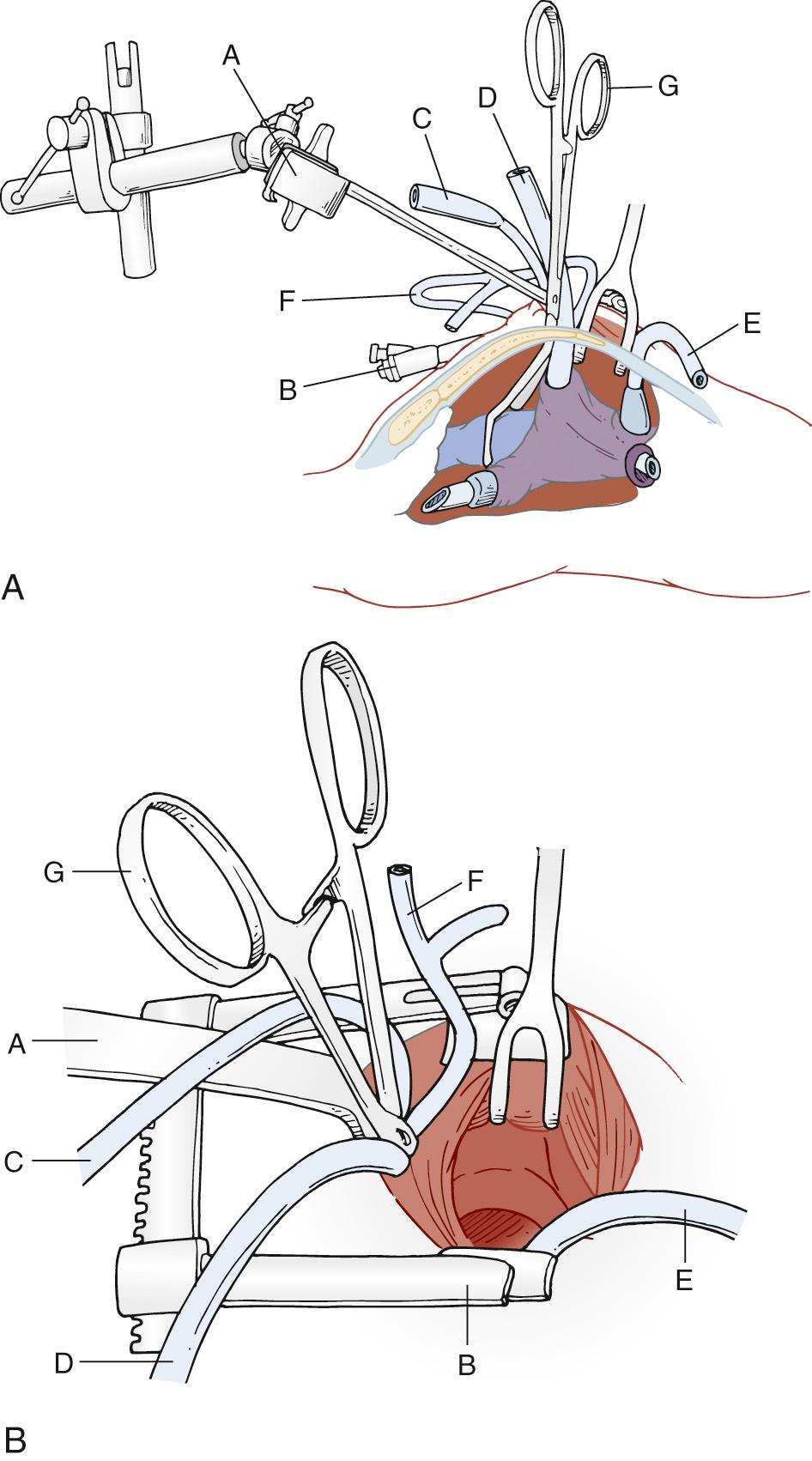
Cardiopulmonary bypass with moderate hypothermia and bicaval cannulation is used in nearly all cases; deep hypothermic circulatory arrest is rarely required. Aortic cross-clamping and cardioplegia are used in all cases to facilitate repair, particularly during the attachment of the septal patches near the AV node and coronary sinus.
In the setting of a large ostium primum ASD, both AV valves and intraventricular anatomy can be readily visualized. If a small or absent interatrial communication is present, then an incision in the septum primum provides access to the left AV valve for valve testing and cleft closure. This also aids in securing the VSD patch to the crest of the interventricular septum.
In complete AV canal defects, there is usually a large ostium primum defect and a moderate to large nonrestrictive VSD under the superior and inferior bridging leaflets ( Fig. 116-5 ). There may be chordal attachments of either bridging leaflet, or both, to the crest of the septum, and these leaflets may be partitioned into right and left components or may form a single bridging leaflet over the crest of the septum. Two surgical approaches have been developed and are commonly used in this setting. A double-patch technique involves the placement of two separate patches, one to close the VSD and the other to close the ASD. Alternatively, a single-patch technique with autologous pericardium is used to close the VSD and ASD components, often with division of the superior bridging leaflet. More recently, a modified single-patch technique has been introduced, where the VSD is obliterated by suturing the bridging leaflets to the crest of the interventricular septum; a single pericardial patch is then used to close the ASD. Although there are advantages and disadvantages to each technique, excellent results have been reported with all three methods.
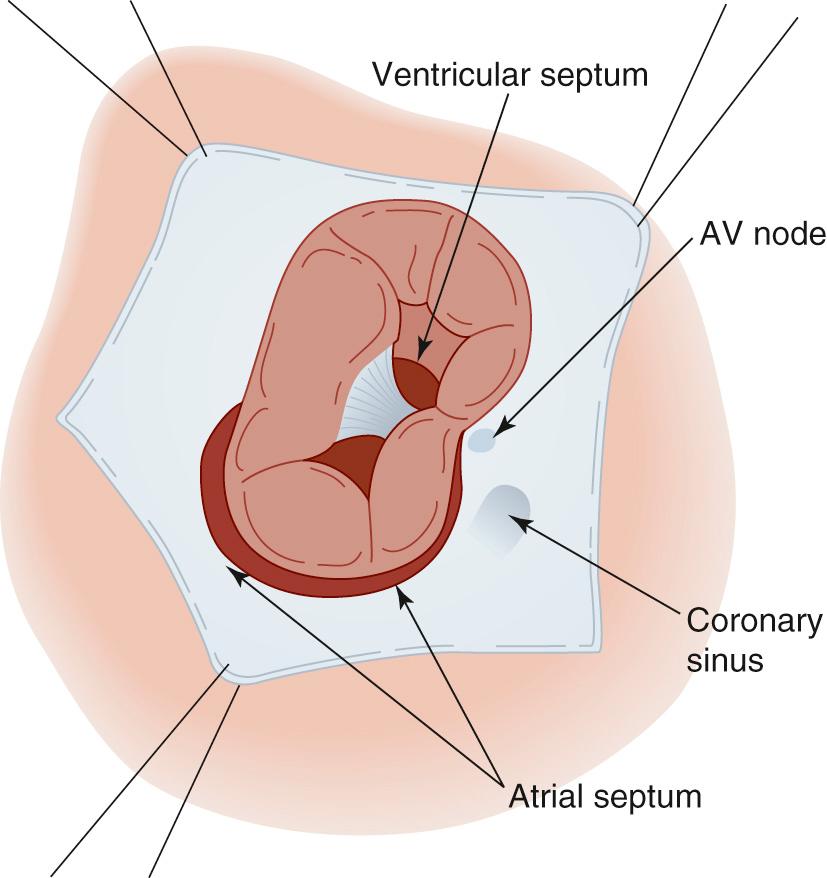
In the double-patch technique, separate patches are used for closure of the ventricular and atrial septal defects. The ventricular patch is made of synthetic material, such as Dacron, or glutaraldehyde-treated pericardium. The atrial patch is usually autologous pericardium, either untreated or treated with glutaraldehyde. The use of a synthetic atrial patch should be avoided, because hemolysis can result when a left AV valve regurgitant jet strikes the patch.
Initial inspection of the AV valve and filling of the left ventricle with cold saline facilitates the delineation of the point of coaptation of the left superior and inferior bridging leaflets. This permits measurement of the base-to-apex dimension of the VSD at the point of leaflet coaptation, corresponding to the height of the VSD patch. The distance between the two junction points of the interventricular septum and the AV valve annulus, at the aortic valve cephalad and the AV node caudad, should also be determined. This is helpful in determining the width of the VSD patch.
The patch shape is that of a crescent rather than a half circle because of the apical displacement of the point of coaptation of the superior and inferior bridging leaflets ( Fig. 116-6 A ). The VSD patch is attached to the right of the crest of the interventricular septum using running or horizontal mattress interrupted pledgeted sutures. Care should be taken to avoid distortion of valve chordae that attach to the septum. As the suture line approaches the AV node area, the patch is attached more to the right of the septum, fixed 3 to 4 mm away from the junction of the interventricular septum and the AV valve.
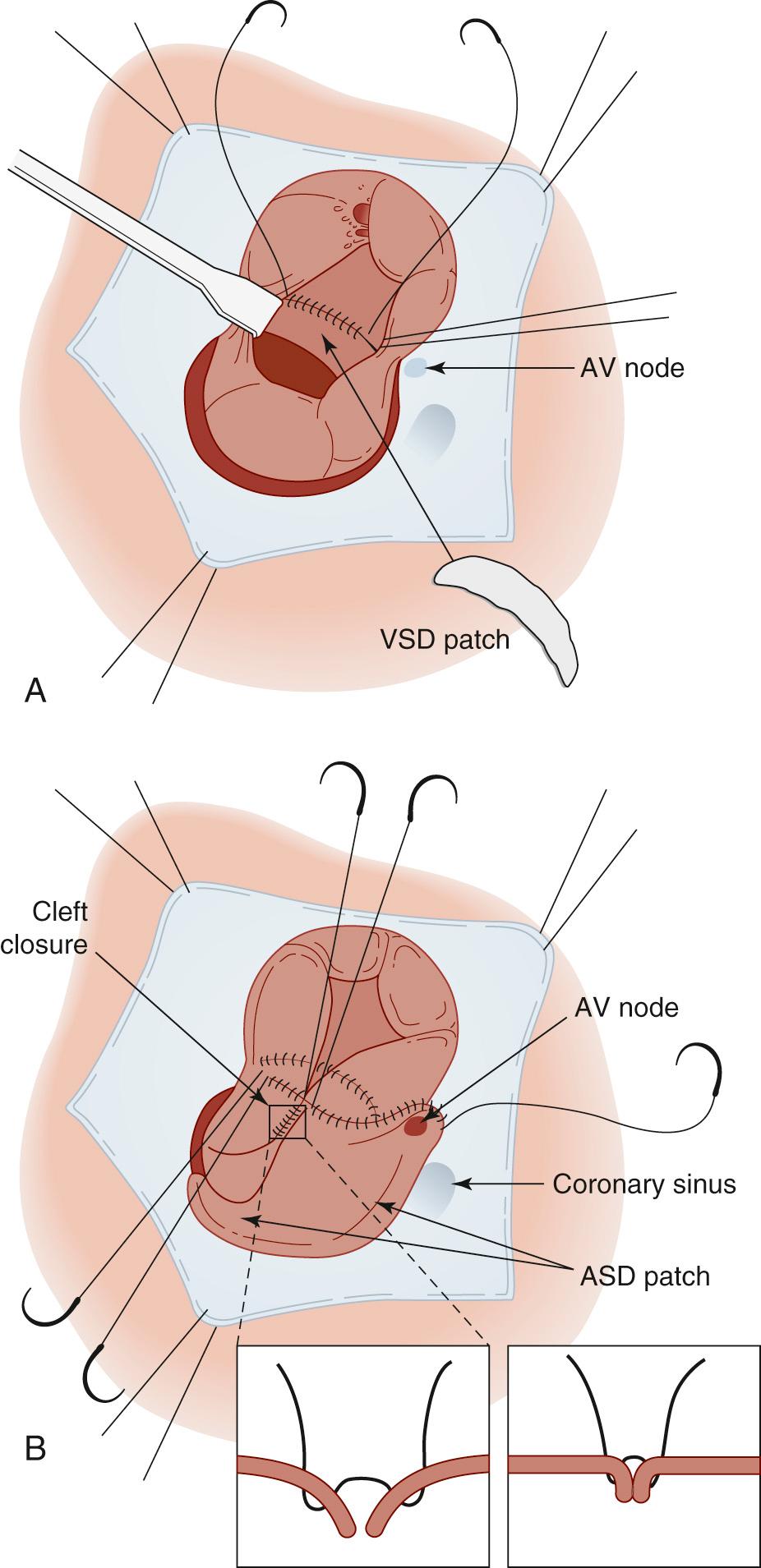
The superior and inferior leaflets are then draped over the edge of the VSD patch. The pericardial patch is cut to an appropriate width, made narrower than the true distance between the aortic valve and the AV node to perform an annuloplasty of the AV valve, thereby decreasing the incidence of MR. A running horizontal suture line is performed to sandwich the AV valve leaflets between the VSD and ASD patches. These sutures pass through the pericardial patch, the left AV valve leaflets, the VSD Dacron patch, and the right AV valve leaflets (see Fig. 116-6 B ).
The mitral valve cleft, created by coaptation of the superior and inferior bridging leaflets, is then closed, using either running or interrupted horizontal mattress sutures ( Fig. 116-7 A, B ). Our preferred technique is the double-layer cleft closure. The first layer is a horizontal mattress layer, and the second layer is a simple running over-and-over suture, which is not tightened but left loose enough to help the pliability of the unified leaflet. The extent of cleft closure is determined in great part by the position of the papillary muscles and the size of the left lateral leaflet. Because closure of the cleft limits mobility of the superior and inferior leaflets, the greater the valve orifice area that is covered by these two leaflets, the greater the chance for creating valve stenosis. When the papillary muscles are close together or a single papillary muscle is present, closure of the cleft creates a slit-like orifice of the mitral valve, resulting in significant stenosis. In these cases, the cleft must be left at least partially open to facilitate leaflet mobility. Frequently, the edges of the leaflets creating the cleft are rolled and coapt over a small surface area. Care must be taken to preserve this degree of coaptation in closing the cleft and not to unroll the leaflet edges, because leaflet coaptation adds strength to the cleft closure, particularly during systole, thereby minimizing MR (see Fig. 116-6B ).
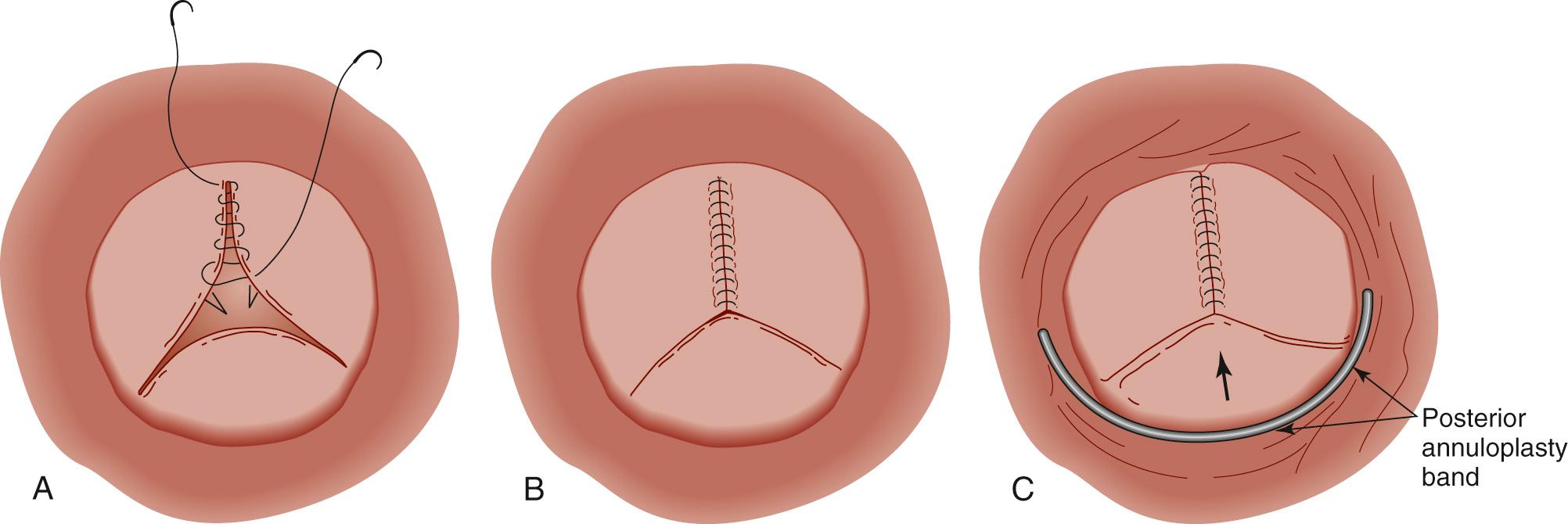
The degree of MR is determined by injecting cold normal saline into the LV cavity. If significant regurgitation is present after cleft closure, then central regurgitation from poor leaflet coaptation is the usual culprit. This is managed by narrowing the commissure between the LSL and the left lateral leaflet and the LIL and lateral leaflet with placation sutures. When there is annular dilation, placing a posterior intra-annular absorbable suture from LIL to LSL suspends the entire lateral leaflet. This brings the left lateral leaflet closer to the interventricular septum and improves central leaflet coaptation. An additional maneuver that we have used when the left lateral leaflet does not coapt well with the sutured anterior leaflet is a posterior suture annuloplasty. We perform this maneuver using an absorbable monofilament suture, placing the suture in the annulus and then tying the suture over an appropriate sound to avoid valve stenosis. Commercially available posterior annuloplasty bands made of absorbable material can also be useful in cases of recurrent AV valve regurgitation (see Fig. 116-7 C ).
The ASD patch is then sutured to the remnants of the interatrial septum. The two surgical options available for avoiding injury to the AV node are attachment of the patch to the right or to the left of the AV node. Attaching the ASD patch to the right of the AV node involves suturing to the right inferior leaflet, where superficial bites are taken. The suturing continues to the right of the coronary sinus orifice, leaving the coronary sinus draining into the left atrium ( Fig. 116-8 A ). Alternatively, the suturing can be extended to the edge of the coronary sinus orifice, leaving the orifice on the right atrial side (see Fig. 116-8 B ). The advantage of placing the patch to the right of the coronary sinus ostium is that the suture line remains far from conduction tissue. The disadvantage is that the coronary sinus is left draining to the left atrium. This can cause variable degrees of obstruction to coronary sinus drainage unless the coronary sinus is surgically unroofed. The arterial saturation is typically minimally affected. In a variant of this latter technique, the ASD patch can be attached to the left inferior leaflet, gradually returning to the edge of the interatrial septum, as initially advocated by McGoon and colleagues. This leaves the coronary sinus draining into the right atrium. The disadvantage of this technique is that sutures must be placed through the LIL; in small infants, these sutures can tear through the delicate leaflet tissue or distort the leaflet enough to cause significant MR. In patients with complete AV canal and a left superior vena cava draining to the coronary sinus, the patch should be to the right of the AV node and sutured to the edge of the coronary sinus ostium, leaving the ostium draining into the right atrium (see Fig. 116-8 B ).
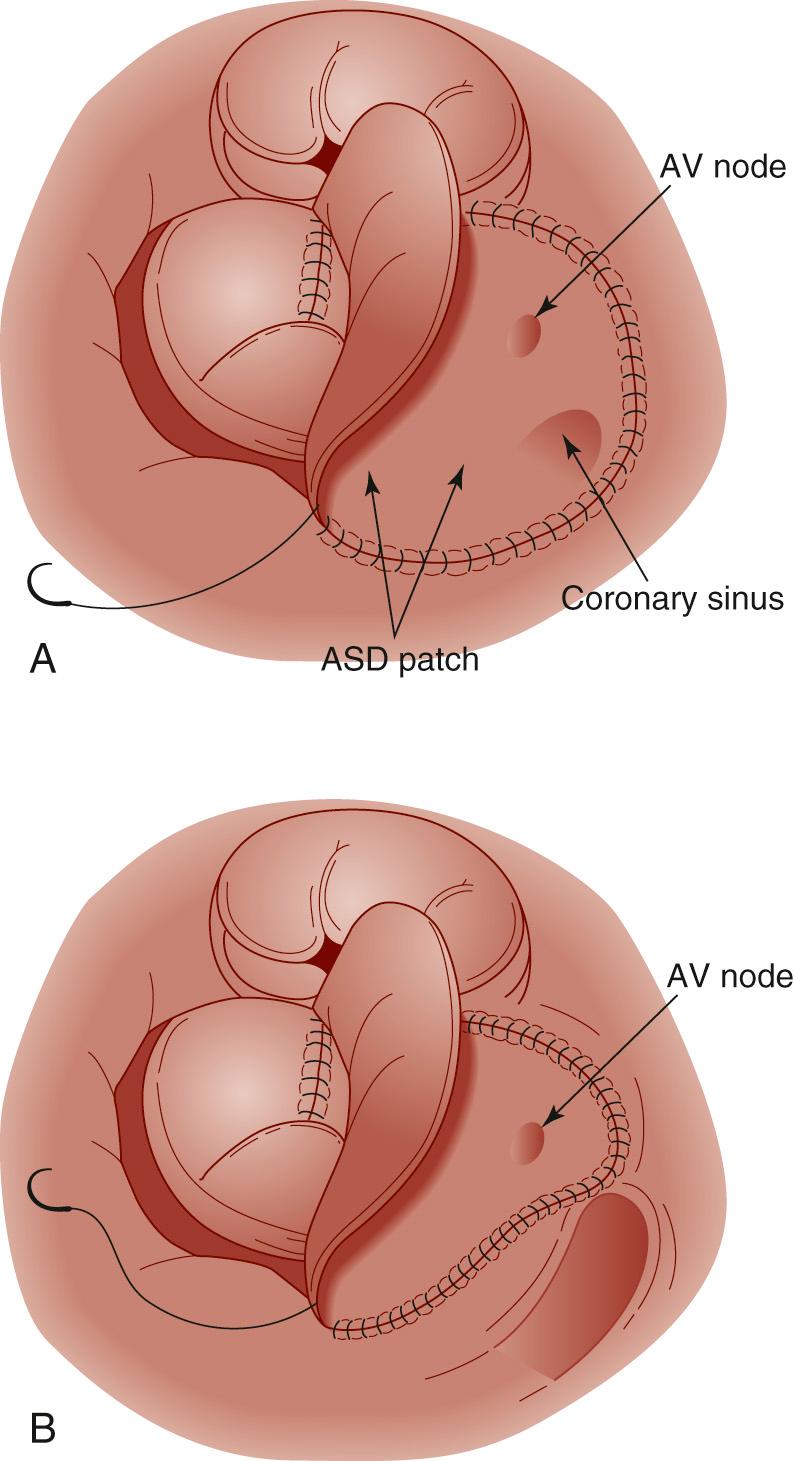
Become a Clinical Tree membership for Full access and enjoy Unlimited articles
If you are a member. Log in here